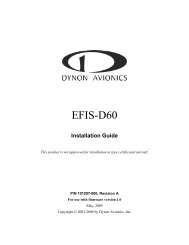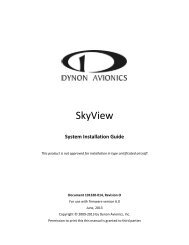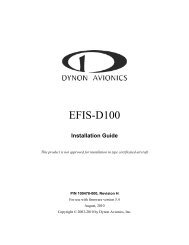Create successful ePaper yourself
Turn your PDF publications into a flip-book with our unique Google optimized e-Paper software.
Autopilot Servo Installation, Configuration, and CalibrationForum is especially useful for pilots with uncommon aircraft or unusual installation issues. Forcustomers that cannot call <strong>Dynon</strong> Technical Support during our normal business hours, theForum is a convenient way to interact with <strong>Dynon</strong> <strong>Avionics</strong> Technical Support. The Forumallows online sharing of wiring diagrams, photos, and other types of electronic files.<strong>Dynon</strong> will continue to develop kits and installation instructions for more aircraft based ondemand. It is also expected that aircraft manufacturers will develop their own mounting kits for<strong>Dynon</strong> servos or offer the <strong>Dynon</strong> AP as a factory option. If <strong>Dynon</strong> does not currently offer amounting kit for your particular aircraft, and you would be inclined to assist in developing a kitand documentation, please send an introductory email message about your interest tobetatest@dynonavionics.com.Servo Mechanical Installation<strong>Dynon</strong> <strong>Avionics</strong> has researched suitable mounting points for a number of popular aircraft andoffers mounting kits and instructions for them. If you have purchased one of these kits, use theinstructions included with it as your primary guide; the following mechanical installationinformation is more general in nature. If you have purchased cable-drive capstan servos (SV32Cor SV42C), refer to the documentation that came with the included Capstan Accessory Kit(101116-000).For installing <strong>Dynon</strong> <strong>Avionics</strong> servos in aircraft for which <strong>Dynon</strong> does not offer kits, we offer aGeneric Servo Installation Kit (101020-000) of basic parts and basic installation instructions. Thegeneric servo push-pull mounting kit includes some of the hardware to mount a servo andconnect to the aircraft controls, but requires the installer to fabricate mounting brackets. Thiskit can be used in either pitch or roll applications that use a servo with an output arm (notsuitable for use with pulley/cable servos). Some additional fasteners (not supplied by <strong>Dynon</strong>)and brackets will be required depending on the installation method chosen.Neglecting to properly install and/or use <strong>Dynon</strong> <strong>Avionics</strong> AP hardware can result infailures which could cause loss of aircraft control resulting in aircraft damage,personal injury, or death. If there are any questions on the part of the installer it ismandatory to resolve these questions prior to flight.When installing the servo, you must first determine a mount location for proper interactionwith the existing control system. The mounting point that is chosen must allow the servo armand associated linkage to move freely through the entire range of travel. To prevent thepossibility of the servo arm going OVER CENTER, the servo arm must not travel more than atotal of +/-60° from neutral position. When the aircraft controls are centered, the arm of theservo should be perpendicular to the attaching push rod. If this is not the case, we recommendadjusting the length of the push rod or consider a different mounting point. For maximumefficiency and the lightest drag on the flight controls, you should choose the smallest servo thatprovides sufficient torque to move and hold the flight controls with a minimum of slippage. Adiagram of servo torque versus mount position is shown on page 10-6.<strong>SkyView</strong> System Installation Guide - Revision J 10-3
















